Speech The Present and Possible Future of Secured Issuance
The funding of the banking system has very much been front and centre at various times throughout the financial crisis, and it is under heavy scrutiny again.
The particular aspect of bank funding that I want to focus on today is the role of secured funding, a topic at the heart of a conference on securitisation. The development I wish to highlight is the quite divergent trends in the composition of bank funding over the past four years, particularly in terms of the share of secured versus unsecured funding. The most striking example is in Europe, where banks have raised around half of their wholesale funding in 2011 in the form of secured funding, whereas in the US there has been almost a complete absence of secured funding (outside that raised by the mortgage agencies). Instead the banking system's funding has almost entirely been driven by deposits. In Australia, the composition of bank funding has also changed over the past four years, in a manner more along the lines of the US than the European experience.
These developments reflect changes on both the supply and demand side including:
- Banking systems generally have experienced slow (or even negative) growth on the asset side of the balance sheet but deposit growth has been considerably faster. Hence, customer deposits, both retail and corporate, have accounted for a considerably larger share of bank funding than they did pre-crisis. As a result, the need for banks to raise funds in wholesale markets has declined.
- Investors, particularly over the past year and particularly in Europe, have exhibited a strong preference to purchase secured forms of funding from banks. As I will discuss later, it is not clear to me that the delineation between secured and unsecured funding for the banking system is quite so stark as current market conditions would imply.
At this point, it is worth thinking about the various forms of funding available to banks. For the purposes of this talk I will simplify these into five categories:
- Equity raising.
- Deposits, some portion of which may be insured or guaranteed.
- Unsecured wholesale funding, in the form of bond issuance or short-term paper.
- Asset-backed issuance, such as residential mortgage backed securities (RMBS), where the bank sells a security backed by a pool of assets to the market. The assets are no longer present on the bank's books after the sale.
- Covered bonds, where the issuance is again backed by a pool of assets. However, in this case, the assets remain on the balance sheet of the issuing bank, and the investor is given an additional claim on the balance sheet of the bank.
Note that the first three forms of funding are claims on the bank's balance sheet as a whole. In the case of deposits, in many countries, insurance or guarantees provide protection up to some level but any deposit larger than that is a form of unsecured funding. Asset-backed issuance is obviously secured issuance, while covered bonds are primarily secured issuance but with an element of unsecured funding in terms of the recourse to the balance sheet as a whole.
Today I will focus primarily on the last three modes of funding, generally characterised as wholesale funding. First I will summarise developments in bank funding in Australia, the US, Europe and UK since the financial crisis began over four years ago. Central bank actions in each of these areas have had implications for bank funding, so I will then spend a little time discussing this issue. Finally I will pose some questions about how wholesale funding might evolve in the future, focussing particularly on the sustainability and desirability of the current investor preference for secured issuance.
Present
Graphs 1 to 4 show the patterns of bank wholesale funding over the past five years in the US, UK, Europe and Australia, using the taxonomy described above.[1] The one additional source of wholesale funding (not described above) is government-guaranteed bond issuance for the period from September 2008 until the cessation of the guarantee on new issuance.
In every case bar Australia, it is noteworthy that the level of wholesale issuance in 2011 is substantially below that in 2007. To a large extent, this reflects the fact that outside Australia, credit growth has been very low or even negative for much of this period (Graph 5 below). The other important factor, mentioned earlier, is the relatively strong growth in deposits in all four regions. This trend is well documented for the US, Europe and the UK in a graph from a recent paper published by some of my colleagues on the Committee on the Global Financial System.[2] In Australia, since mid 2007, deposits have grown at an annualised pace of 11 per cent, compared with credit growth of 5 per cent. As a result, while the level of wholesale issuance by Australian banks in 2011 is about the same as that in 2007, it is a significantly smaller share of total bank funding.
In the US, there are three developments that stand out. First, is the marked decline in the issuance of non-agency mortgage-backed securities. In 2010 and 2011, almost all of the mortgage-backed securities (MBS) issuance in the US has been by the agencies. As you recall, the agencies purchase eligible loans from mortgage originators (including banks) and either keep them on their own balance sheets or pool them into MBS to be sold to investors. (They can also provide guarantees to MBS issued by approved lenders and purchase MBS to hold on their own balance sheets.) Second is the significant decline in unsecured bond issuance from 20 per cent of wholesale funding in 2007 to 11 per cent in 2011.

The change in issuance patterns in the US is also affected by the fact that a sizeable share of housing lending in the US was funded off balance sheet. As that source of housing finance has dried up significantly, and housing lending growth has been negative for more than two years now, a much greater share of lending has been in the ‘conforming’ market supported by the agencies. So the changes in funding are much larger for the shadow banking system in the US, than they are for the balance sheet funding of the banking system.
More generally, when comparing the changes in funding across the four regions, it is important to bear in mind that a significantly smaller share of finance to both the household and business sectors was, and is, provided by the banking system in the US than in the other regions.
In Europe, unsecured issuance accounted for a little over half of total issuance in 2011, a similar share to 2007. However, the issuance pattern varies quite markedly across institutions. The stronger institutions have generally had ready access to unsecured funding, but a number of institutions have been shut out of unsecured markets, particularly since the middle of this year. The composition of secured funding has changed dramatically, with covered issuance accounting for the vast bulk of secured issuance in 2011, compared with a roughly equal split in 2007. The covered market has been the primary funding source for those institutions unable to tap unsecured markets. But the secured issuance data are also significantly affected by ‘self-securitised’ issues, both MBS and covered, which are retained on the balance sheet of European financial institutions to access liquidity at the ECB (see below).[3] Finally, the aggregate figures for Europe mask some quite significant differences across countries and institutions with, for example, secured issuance by German institutions almost entirely in the form of covered bonds (pfandbriefe) while banks in the Netherlands issue RMBS.
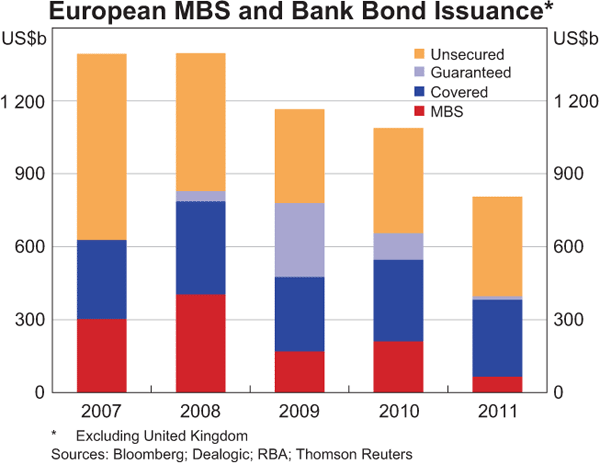
In the UK, the share of unsecured issuance in total issuance is about the same in
2011 as it was in 2007, at just over 50 per cent. However, total unsecured
issuance is significantly smaller in 2011 than in 2007. The share of funding
from MBS has declined but has been fully compensated for by an increase in
the share of covered bond issuance. Note that part of this shift reflects a
compositional shift in the industry. Entities such as Northern Rock, which
sourced a large share of their funding from MBS, were a large part of the market
in 2007 but are obviously not so today. A final point on the UK data: the large
amount of MBS in 2008 predominantly reflects ‘self-securitised’
issuance in order to access the Special Liquidity Scheme (SLS) at the Bank
of England; more on which shortly.
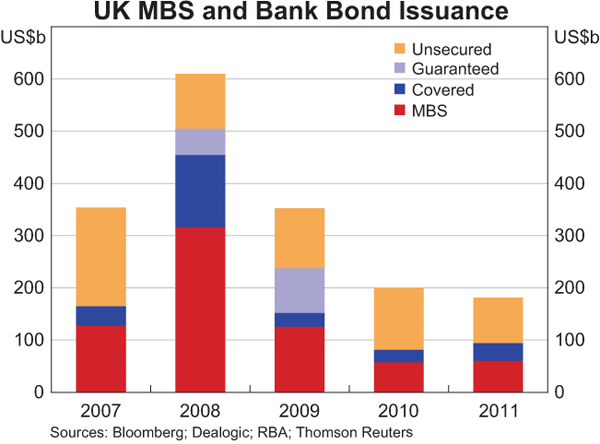
In Australia, the share of unsecured funding has actually increased between 2007 and 2011, in contrast to the other regions. In large part this reflects a compositional effect. A number of institutions, some banks but particularly non-banks, were significantly more reliant on MBS for their funding than the larger banks. Following the dislocation in the MBS market, the larger banks now account for a much larger share of the financial sector in 2011 than they did in 2007.
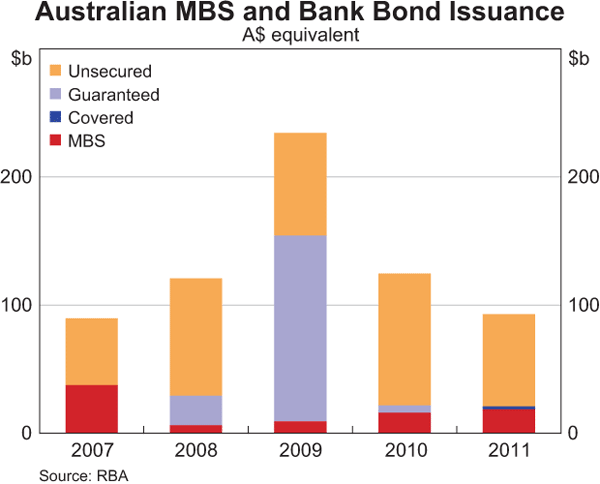
Obviously in Australia, the covered bond market is in its infancy, with the first issue only last week, following the passage of enabling legislation in October. So nearly all the secured issuance this year has been in the form of MBS.
Credit growth in Australia, while slow relative to recent Australian history, has outstripped that in the other three regions (Graph 5). But it is apparent from the Australian data that total wholesale issuance is broadly the same in 2011 as it was in 2007, and hence a smaller share of overall funding, with deposits accounting for the difference.
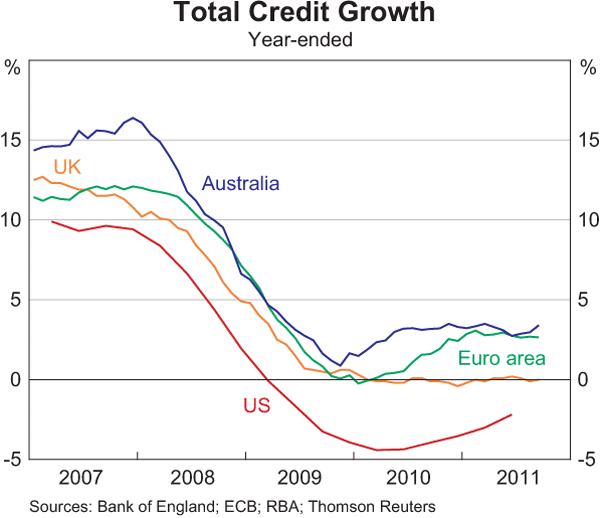
Differences in Central Bank Support
The nature of central bank support has also had an influence on the developments in bank funding. The balance sheets of the Fed, ECB and Bank of England have increased significantly since 2007. The ECB's balance sheet has approximately doubled, while those of the Fed and the Bank of England have roughly tripled over the past four years (Graph 6). The Reserve Bank of Australia's balance sheet, while increasing in 2008,[4] is smaller than it was in 2007 (reflecting the withdrawal of deposits at the RBA by the Future Fund to invest in a broader range of assets).
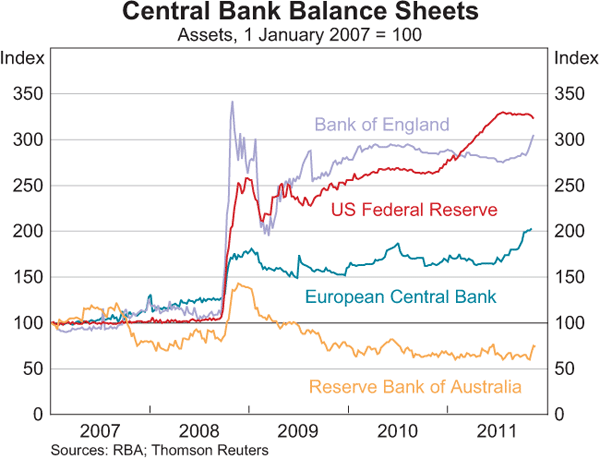
In the US, the Fed's program of quantitative easing has injected a large amount of liquidity into the banking system. Moreover, the Fed's program of asset purchases has included over US$1 trillion of mortgage-backed securities.
Similarly in the UK, the Bank of England has conducted a large asset purchase program. It has also provided support to the banking system through the Special Liquidity Scheme, whereby banks were able to exchange MBS or covered bonds for Treasury Bills to more easily obtain liquidity in the market. At its peak, £287 billion of securities were exchanged for £185 billion of bills. Drawdowns under this scheme closed in January 2009, and a large part has been repaid this year with the remainder to be repaid by January 2012.
In Europe, the ECB has assisted bank funding through its fixed rate full allotment liquidity provision operations. This has enabled banks that are having difficulties obtaining funding in the market to borrow from the ECB against acceptable collateral at the ECB's policy rate for terms of up to one year or so. As mentioned above, some of this collateral has taken the form of secured issuance retained on the books of the issuing bank. The ECB has also supported bank issuance through its covered bond purchase program. In its initial phase, which commenced in July 2009, the ECB purchased €60 billion in covered bonds. It has recently restarted the program with the intention to purchase a further €40 billion.
In Australia, the RBA provided liquidity support to the banking system through its repurchase operations, including against self-securitised mortgages, at the height of the dislocation in funding markets in 2008 and 2009. But the RBA's liquidity provision has been at normal levels for over two years now.
Future
The first part of my talk today has summarised the current state of affairs in wholesale funding markets. In the final part of my speech, I will briefly discuss how things might evolve in the future.
There is a clear preference on the part of investors in the current risk-averse climate for secured investments. A number of financial institutions, particularly in Europe, have been only able to access funding through covered bonds.
I don't see this trend towards predominantly secured issuance as being sustainable. A difficult message for this forum to digest I know, but securitisation is not the be all and end all of funding!
Banks can't encumber their balance sheets through secured issuance to such an extent that unsecured issuance, and even deposit gathering, is no longer possible. Too much issuance of covered bonds and you're effectively back in the unsecured world. Hence most jurisdictions put a cap on the amount of covered bonds that can be issued. In Australia, the cap on the total amount of encumbrance is 8 per cent which, given the degree of over-collateralisation in covered bonds, translates into an issuance level below that, and well below a level which is likely to compromise the safety of deposits.
Nevertheless, the introduction of covered bonds does subordinate unsecured debt holders to a degree. Any pricing gain obtained from issuing covered bonds is likely to be offset to some extent by a demand from unsecured debt holders for more compensation in the future. So I see the role of covered bonds as primarily broadening the potential investor base rather than a means of reducing overall funding costs for banks. There is clearly a segmented investor base. Some investors will only buy covered bonds and have no interest in RMBS or unsecured paper. Other investors are completely happy with RMBS and have no interest in covered bonds which pay a lower yield for a similar credit exposure. I would expect that covered bonds are likely to be primarily an offshore funding source for the Australian banks with the domestic investor base more comfortable with RMBS.
In that regard, it is worth posing the question as to how different the various forms of bank funding actually are. All of the forms of funding are claims on a bank's balance sheet in one form or another. Unsecured bank funding (including deposits) is a claim on the balance sheet of the bank as a whole. The assets underpinning that claim are the same form as those which back the secured issuance.
An RMBS is not an on-balance sheet claim, but is a claim on a set of assets very much representative of a sizeable part of the balance sheet. In Australia, at least, the mortgages which are securitised by banks in their RMBS issues have similar characteristics to those mortgages which remain on the banks' balance sheets. The same is also true of the forthcoming covered bond issues by the Australian banks. So the underlying assets aren't that much different, rather the difference is in the degree of credit enhancement provided by subordination in the case of RMBS or over-collateralisation (and additional recourse to the balance sheet) in the case of covered bonds.
The strong motivation for the current preference of investors for secured issuance is about repositioning themselves towards the front of the creditor queue. That is the fundamental point of differentiation between the various forms of funding. But ultimately, everyone can't be at the front of the queue.
In theory, or in a less risk-averse environment than the current one, pricing should equalise the incentives to issue and purchase the various forms of funding. Investors should be compensated for their risk of being further down the creditor queue with a higher risk premium. But in today's environment, there are plenty of examples where market pricing is not always sending the most accurate signal. In due course, investors in bank paper might again come to the realisation that there is not as stark a difference between secured and unsecured issuance, as current pricing would suggest. Investors need to heed the seminal words of The Saints: ‘Know Your Product’ and do the necessary due diligence.
So in the end, I think we should return to a world where banks access all five of the sources of funding I outlined at the beginning of my talk. It is useful to have a diverse range of funding instruments at hand, as at various points in time, some markets are more functional than others. A world where the only source of funding available is secured is just not sustainable.
Endnotes
Thanks to Craig Evans, Justin Fabo, Tom Rosewall and Claudia Seibold for their assistance and helpful discussions. [*]
Note that private placements are not well captured in the data used here, except in the case of Australia. [1]
See Graph A4.1 in ‘The Impact of Sovereign Credit Risk on Bank Funding Conditions’, Committee on the Global Financial System, Paper No 43, July 2011. [2]
For more detail, see ‘Recent Developments in Securitisation’, European Central Bank, February 2011. [3]
See the ‘Operations in Financial Markets’ chapters in the Reserve Bank of Australia Annual Reports of 2009 and 2010 for more discussion. [4]
